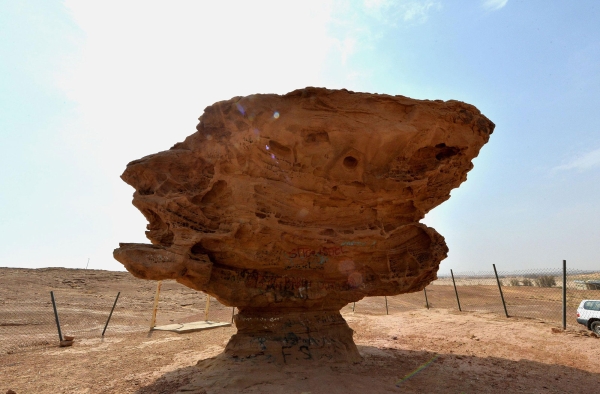

Antarah's Palace and Rock are two archaeological sites associated with the pre-Islamic poet Antarah Ibn Shaddad, who resided between the town of Qusayba and the Uyun al-Jiwa Governorate, within Qassim Province at the heart of the Kingdom of Saudi Arabia. These sites encompass a vast expanse known as (al-Jiwa), referenced by Antarah in his poetry with the phrase "O Abla's house in al-Jiwa, speak."
Location of Antarah's Rock
It is located in Ghaf al-Jiwa Center, part of Uyun al-Jiwa Governorate. The rock serves as evidence of the life of Antarah and his first cousin, Abla, which unfolded between the Rock of Antarah and Hussat al-Nasslah, both situated to the north of Ghaf al-Jiwa Center. Hussat al-Nasslah is a substantial rock formation, distinguished by its conical shape, shaped by weathering and wind erosion. Thamudic inscriptions and distinct rock drawings depicting ibexes, camels, and various markings adorn its surface.
Location of Antarah's Palace
Located at the peak of a rocky plateau known as "Jal Qusaiba," it is referenced by Antarah in his poems as "Qo." Near the town of al-Quarah, on the western edge of Qusaiba, the remnants of an ancient stone palace were discovered. Legend has it that this is the site where Antarah Ibn Shaddad engaged in battle and met his defeat. Qusaiba is a low-elevation area where rainwater collects in its center. Its periphery is delineated by mountains encircling the village from all directions. Historically known as "Qo," meaning a low place, Qusaiba was inhabited by the Bani Abs during the pre-Islamic era and continued to be inhabited during the emergence of Islam. Additionally, Qusaiba boasts numerous archaeological structures such as watchtowers, springs, and wells.
Places related to Antarah's life
The places where Antar lived have become open-air museums. They comprise the ruins of his palace and towers constructed from stones, situated atop the western side of Jal Qusaiba. They were used to guard and monitor water springs, palm groves, and several pilgrimage caravan routes that traversed the region.
Related quizzes
Related articles
